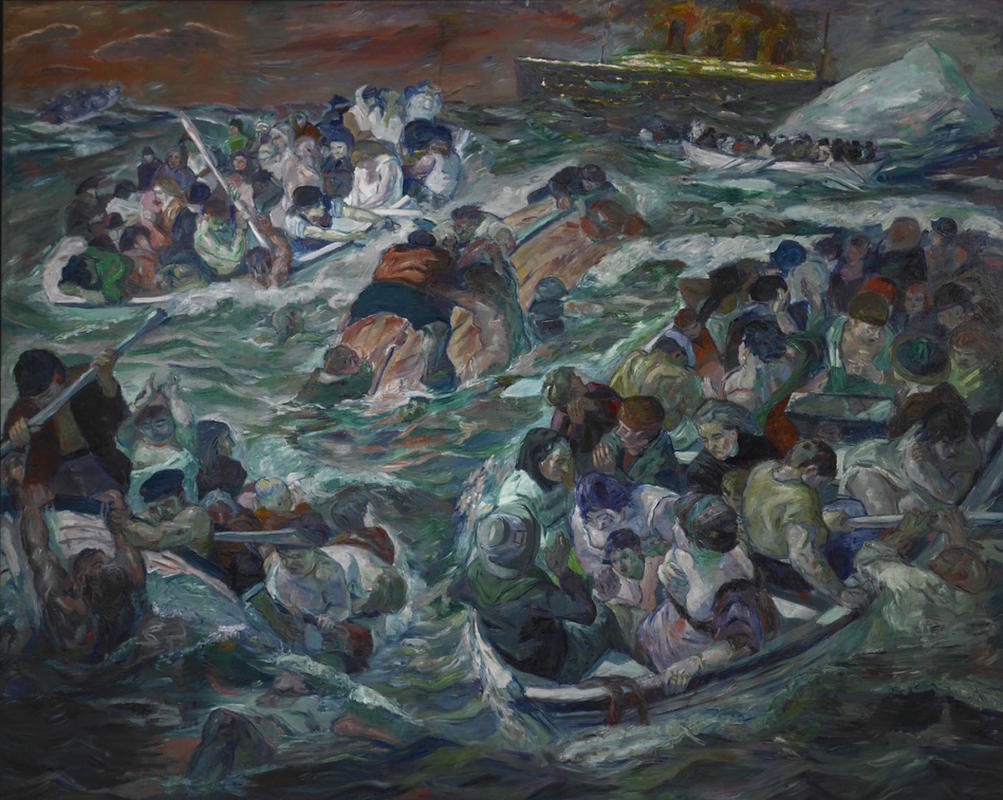More about Sinking of the Titanic
- All
- Info
- Shop

Sr. Contributor
For 1997’s Titanic, it seems like James Cameron might have taken a page right out of Max Beckmann’s book.
If you’re anything like me, you’ve seen Titanic more times than you can count and, yet, still need an entire box of tissues each and every time. But the story of the Titanic isn’t just a timeless, cinematic romance for the ages. The actual sinking of the Titanic on April 15, 1912, rocked the world, and newspaper coverage of the tragedy inspired Beckmann to paint how he imagined the scene went down. Perhaps following in the footsteps of another famous shipwreck depicted in Théodore Géricault’s Raft of the Medusa, Beckmann created a dramatic, swirling image of the horrible event. He completed this painting just a year after the ship sank, and it looks oddly like some scenes in the movie that James Cameron directed over 80 years later.
As in Géricault’s disturbing image, Beckmann is probably painting the lower-class people who suffered the brunt of what happened on that fateful night. Although there were some notable passengers, the lowest Third Class made up the majority of the people on the ship. Shout out to our boy Jack Dawson. Some notables included John Jacob Astor IV; Isidor Straus, the owner of the department store Macy’s, and wife Ida; and the “Unsinkable” Molly Brown, the historical figure who Kathy Bates brought to life in the movie. J.P. Morgan’s name almost made this list, but a last minute business deal (or whatever rich guys do) kept him from boarding the ship. As always, money makes the world go round, and people’s locations on the ship determined their rate of survival. First-class passengers were 44% more likely to survive than those traveling in the other classes!
Despite extensive news coverage on the sinking, Beckmann’s account focuses on terror, leaving out the many heroic stories that later emerged. Instead, Beckmann’s horrified figures are at the whim of the violent sea that surrounds them. But this wasn’t far off for Beckmann’s uniquely freaky style. He continued to paint frightening images after his short service in World War I – an experience that reportedly caused a “great injury to his soul.”
Beckmann was determined to paint scenes from contemporary life in this distinctly creepy style that was very similar to other German Expressionists like his contemporary Ernst Ludwig Kirchner. After the knowledge of human catastrophes like the War and the sinking of the Titanic, Beckmann’s painting continued to be characteristically cynical, and he remained attuned to the world’s ethos in the wake of humanitarian disasters. In Beckmann’s world, we definitely don’t get the same beautiful rendition of nature and the ocean as in Surf-Riders, Honolulu.
Sources
- Arnason, H.H., and Elizabeth C. Mansfield. History of Modern Art. Upper Saddle River: Pearson Education, Inc., 2013.
- Hamilton, George Heard. Painting and Sculpture in Europe 1880–1940. New Haven: Yale University Press, 1993.
- Keaggy, Diane Toroian. “Beckmann work at St. Louis Art Museum depicts Titanic disaster.” St. Louis Post-Dispatch. March 29, 2012. http://www.stltoday.com/entertainment/arts-and-theatre/beckmann-work-at…
- Saint Louis Art Museum. “Max Beckmann.” Art of Europe, 1800–1945, 2010. http://www.slam.org/moderneuropean/works/10.html. Accessed June 5, 2017.
- The History Channel. “Titanic.” Article. http://www.history.com/topics/titanic. Accessed June 5, 2017.












